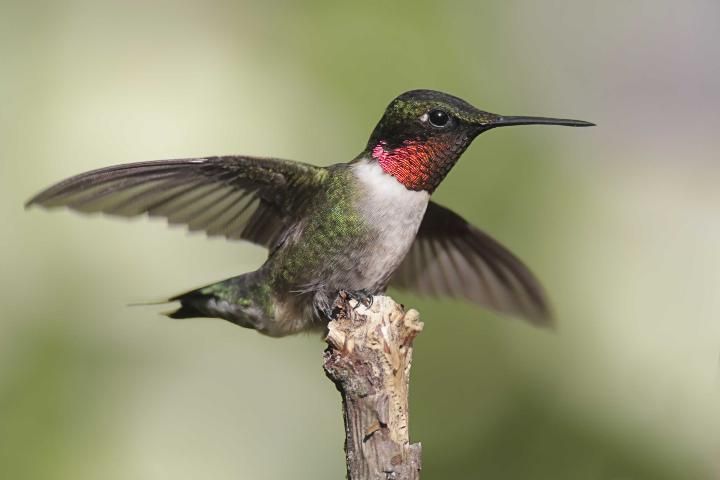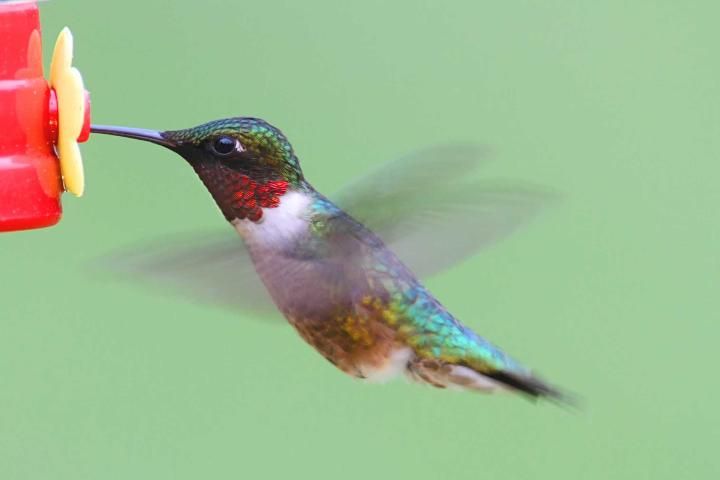Centuries ago their plumage was used to adorn Native American ceremonial costumes. Even today, some people believe that the hummingbird's glittering plumage contains mythical powers. However, most of us merely enjoy watching these sparkling gems of the bird world.
Description
Hummingbirds live only in the Americas. Of the 338 species known, 16 are found in the United States and 3 occur in Florida. Black-chinned and rufous hummingbirds occasionally can be seen in Florida during the winter. The ruby-throated hummingbird (Figure 1) is by far the most common hummer in the state. This feathered jewel is about 3 inches (7.5 centimeters) long and weighs as little as a penny (¼ ounce). Its name describes the most brilliant part of the mature male's plumage. The throat feathers contain air bubbles that give off an iridescent red tone in full light. Their backs are metallic green and they have two sets of tail feathers: two green ones in the center that cover eight outer black ones when they're folded. In females and juveniles, the black feathers have white tips; males lose the white tips as they mature.

Credit: iStockphoto
Range
The ruby-throat's breeding range extends from central Kansas to the east coast and from Saskatchewan to central Florida. Although some birds may stay in south Florida year-round, most winter in Mexico and South America. Males arrive in Florida in March. Females arrive about a week later.
Nesting
Nesting in Florida begins in April. The nest is a walnut-size structure of plant down, adorned with lichens, moss, and bound with spider webs or fine plant fibers. Nests frequently are built over water. The female lays 2 eggs less than ½ inch (1.2 centimeters) long. After 20 days of incubation and 4 weeks of growing, young hummingbirds leave the nest.
Flying Feats
One of the most fascinating things about hummingbirds is their helicopter-like flying stunts. Not only can hummers suspend their bodies in midair as shown in Figure 2, they can also fly backward, upward, even upside down. These maneuvers are possible because of an unique design that allows the wing to move very freely and in almost any direction at the shoulder. Soaring is the only maneuver they can not perform. Contrary to popular belief, hummingbirds do not hum. The sound is made by their rapid wing movements (50–200 beats per second).

Credit: iStockphoto
Feeding
To acquire enough strength to support all of this high-speed activity, hummingbirds need to consume large amounts of high-energy food. Adult hummingbirds feed primarily on nectar. Young are fed insects by their parents, but are switched to a mostly nectar diet by the time they leave the nest. Nectar is an energy-rich food that is used rapidly. One hummingbird may need nectar from hundreds of blossoms every day to maintain its body weight.
Hummingbirds are well adapted to a liquid diet. Long needlelike bills and specially adapted tongues allow them to reach nectar in deep tubular flowers (Figure 1). The last half-inch of the long tongue is divided into equal halves, each grooved on the outside edge to form two tube-like structures. Nectar is drawn into the tongue much the same way liquid travels up a straw. Hummingbirds can lick at a rate of 13 times per second, and their stomach is capable of holding about 0.18 ounces (5 grams) of nectar at one time. They also feed to a lesser extent on insects.
For their size, hummingbirds have among the largest appetites in the bird world. They feed every 10 or 15 minutes from dawn until dusk. During this period, they eat more than half their weight in food and 8 times their weight in water. Hummingbirds have developed 2 adaptations to help them survive the hours of darkness when they cannot feed. First, they eat as much as they can just before dark. During the night, their heart rate and body temperature drop to conserve energy. If they did not go into this sort of daily hibernation stage, they likely would starve.
Artificial Feeders
Artificial feeders will attract hummingbirds. Because feeders can be placed almost anywhere, they increase your opportunities to view hummers from inside your house. However, feeders should not be the sole source of food provided. The sugar solution may appeal to the hummingbirds' sweet tooth, but it provides little nourishment. Nectar is much more than just water and sugar.

Credit: iStockphoto
Packages of instant nectar may be found at many lawn and garden stores. You also can prepare your own solution with 1 part white, granulated, cane sugar to 4 parts water. Boil the sugar solution to help dissolve the sugar. Then allow it to cool before filling a feeder. This concentration is about the same as that in wildflower nectar. Using a sweeter solution, sugar substitutes or honey could be lethal to hummers. It also is not necessary to add red food coloring. The birds will be attracted to the red feeders.
Several different feeder styles are available. The ones with perches are not necessary, but they do provide an unusual view of this bird without its wings beating rapidly. The upside-down jar-and-tube feeders have a tendency to leak.
Most feeders come with bee guards (Figure 2). Although hummingbirds will feed right next to bees, clusters of these insects will keep them away. If ants are attracted, moisten the hanging wire with cooking oil.
Hummingbirds are very possessive of feeders and usually will not tolerate another bird feeding from the same feeder at the same time. The less dominant ones just wait their turn. Juveniles are a bit more sociable than adults. If you are using more than 1 feeder, arrange them at least 10 feet apart so that all can feed peacefully at once.
Place the feeder where rain will not dilute nectar in the end of the tube. Also avoid direct sunlight as heat stimulates bacterial growth.
Sugar solutions must be kept fresh. Florida's hot weather can cause rapid bacterial growth in these feeders and birds that drink contaminated water could die. To avoid this, change the solution every 3-5 days. Clean the feeders with hot water and white vinegar. Do not use soap or chlorine bleach (Clorox™).
Gardening for Hummingbirds
To be successful in keeping hummingbirds around your house, you must garden for them. The ideal flower color is red, orange, or pink. Hummingbirds are not born with an attraction to certain colors but learn by trial and error which flowers give the best results. Because most nectar-bearing flowers within the range of the ruby-throat are red and orange, they quickly come to favor those colors. Hummingbirds also have been known to show an interest in red-colored lipstick, fingernails, and clothing.
Tubular flowers that are either large and solitary or in loose drooping clusters are best. Generally, tubular flowers hold large amounts of nectar at their base.
Blooming season is another important gardening consideration. Nesting hummingbirds will need nectar from March to September. Therefore, your garden should have numerous nectar plants available throughout this time. It is best to plant a variety of species and to arrange these flowers in several groupings. Nesting hummingbirds are very aggressive and territorial around their food source. Having more than one flower garden will allow several hummers to feed at the same time without conflict.
Hummingbird Plants
Certain plants are among the favorites used by hummingbirds in north and central Florida:
While red flowers dominate the list, others have been added to allow for a varied planting. Plants native to Florida often are preferable when given the proper growing conditions for the species.